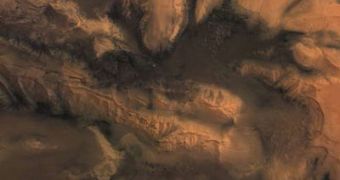While the Grand Canyon in the US may be the most spectacular such formation back on Earth, its splendor is far surpassed by the magnificent beauty of a similar, yet far larger formation on the face of Mars, called Valles Marineris. There are also other differences between the two, such as the fact that geologists actually know how the Grand Canyon formed, whereas its counterpart's origin has been shrouded in mystery until now, Space reports.
“How did these gigantic canyons really form? Were they all formed by floods, or were other things going on? These have been controversial questions going back to the very first Mariner pictures of Mars. And they're still controversial questions, which means we don't really fully understand what's going on yet,” University of Washington in Seattle astronomer John Adams, who is also the lead author of a new study that proposes another explanation for Valles Marineris, says.
The Grand Canyon was most likely formed via erosion, as streams of water constantly dug their way through the layers of soft rock below, over millions of years. For the Martian one, explanations range from massive tectonic activity – such as the one that formed mountains back on Earth – to massive floods, back when the planet still had liquid water on it. Adams proposes that the answer for the Martian mystery can be found in the 190-mile-long (310-kilometer-long) scar cut into the Martian surface, known as Hebes Chasma. The formation is connected to the massive canyon.
Adams and colleagues Alan Gillespie and David Montgomery propose that the chasm formed when heat coming from the underground melted the surface layer of salts. This would have caused water to melt under the surface, and eventually make its way out. This would have, in turn, caused the rocks and soil above to collapse, giving birth to the canyon-like structures we see today. Their idea is supported by the fact that the formation is located near the intensely volcanic Tharsis plateau.
The experts also argue that a large part of the Valles Marineris formed due to the drenching of muddy brines underneath the surface, but, at this point, there is no way of telling for sure just how much of the canyon appeared from these causes, and over what periods of time.

 14 DAY TRIAL //
14 DAY TRIAL //